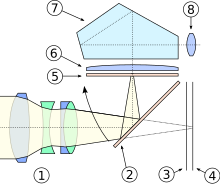Oscillating mirror
The oscillating mirror (also: rear oscillating mirror ) is the typical and eponymous component of a single -lens reflex camera . This is arranged in the camera housing at an angle of 45 degrees to the optical axis and enables the user to preview the motif through the same lens with which the subsequent picture is taken.
function
The subject captured with the camera is usually reflected vertically upwards by the oscillating mirror, and on some models also laterally onto the focusing screen in the camera. The result is a reversed image that can be viewed directly on cameras with a light shaft viewfinder or that is turned correctly into the viewfinder eyepiece via a mirror or prism system.
When taking a picture, the mirror folds up or to the side for the duration of the shutter speed and opens the way to the image plane , with conventional cameras the film, with a digital camera the image sensor . The viewfinder is locked by the folded mirror for the duration of the exposure.
Some cameras offer the option of mirror lock-up (SVA). This setting is intended to avoid blurring due to the impact of the mirror in long exposures . With this function, the mirror is operated manually or automatically a few seconds before the shutter curtain is opened . Some older camera models allow manual locking of the oscillating mirror in the upper position in order to be able to use special lenses, in particular older wide-angle constructions that protrude too far into the camera housing. This function can also be used to reduce blurring.
history
The single-lens reflex principle as such has been known since the 17th century, cameras that work according to it since the 19th century. However, the oscillating mirror has only been used in series production since 1936. In the early versions of this technology, the mirror remains up after the shutter release and the viewfinder remains dark. The mirror is folded down again manually or coupled with the film transport or with the shutter lift. In 1939, a rear-view mirror coupled with the release button was realized for the first time in the Praktiflex . In 1948 Jenő Dulovits first used today's standard swing-back mirror in the Duflex, which opens the viewfinder again immediately after the shutter has expired . It was also the first 35 mm single-lens reflex camera for the viewfinder view at eye level that is common today, with a laterally correct, upright image - however, it did not use a roof prism, but individual mirrors.
Digital mini and compact cameras also show the exact image section on the electronic viewfinder that the lens is generating, but do not have a mirror mechanism, but use the recording sensor directly. This means that they have handling advantages over digital single-lens reflex cameras (DSLR), especially when using swiveling displays, in some shooting situations, such as when shooting close to the ground. Incorrect exposures caused by exceeding the contrast range of the exposure sensor can also be detected before the exposure. However, there are also models of digital SLR cameras that generate a live preview on the display with the help of a semi-transparent mirror, a second sensor or mirror lock-up. The disadvantage of the live preview is the increased power consumption due to the permanently switched on recording sensor and the display. This results in a shorter operating time per battery charge and heats the recording sensor, which increases the noise in the image . Another disadvantage of the display preview via shutter release is that the phase autofocus cannot be used during this time.
- See also: How a single lens reflex camera works



